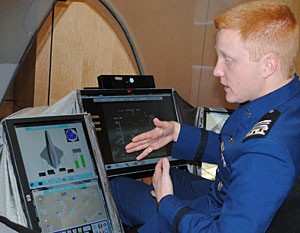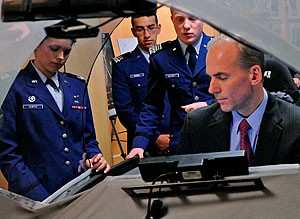Cadets Win Boeing-Sponsored Crew System 2035 competition
By 2035, fighter jets might become so advanced that a pilot
could control a fleet of unmanned air and ground vehicles from the
cockpit, flip a switch to transform a canopy into a laser beam
shield, select a target with the wink of an eye, or even talk to
the aircraft to fire a weapon. The cockpit could also be highly
personalized for greater comfort, including grips that mold to a
pilot's hands, and thin touchscreens that are easily
repositioned.

Cadet 1st Class Andrew Whitmey
These advanced technologies are among a host of innovations that
a team of 15 senior cadets at the U.S. Air Force Academy included
in their design in the first Boeing-sponsored Crew System 2035
competition. Their work propelled them to victory in what was
described as a close contest with the U.S. Naval Academy and U.S.
Military Academy.
At a May 6 event recognizing their achievement, the future
officers said they were honored by the award and learned many
things that will prepare them for their Air Force careers. "I'm off
to pilot training after graduation, so this is definitely a step in
the right direction to understand what goes into cockpit
engineering," said Cadet 1st Class Ryan Zielinski of Las Vegas.
"Definitely a cool project to be on."
Brig. Gen. Dana Born, the academy's dean of faculty, thanked
Boeing for the opportunity to work on a "real project" that helped
motivate the cadets and develop the next generation of Air Force
officers. "This project is an example of what partnering can do,"
Born said. "We're glad for the results. We're even more glad with
the learning that occurred that will benefit our Air Force for
years to come."
Cadet 1st Class Andrew Whitmey of Dana Point, CA, said the
competition gave him the opportunity to experience working with a
large group over an extended period of time. "I got a lot of good
technical aspects of what being a pilot is like, but I think the
biggest impact on me in my career will be the teamwork aspects from
this project," Whitmey said. Over the past year, the cadets studied
what technologies would be mature enough to be incorporated into a
cockpit in 25 years. Then they designed and built a full-scale
mockup.
"In the beginning, it was a lot of research and arguing about
which technology we thought was best because it's hard to decide
what works well versus what could work well in the future," said
Cadet 1st Class Caroline Kurtz of Albuquerque, NM. "And then the
second semester, it was debating about how to actually make all
these technologies interact and define the backups if something
does fail."

Dennis Muilenburg, President and CEO of Boeing Defense,
Space & Security
Lt. Col. Carlene Perry, the cadets' instructor, said the Air
Force will benefit significantly from the insights the cadets
gained from the competition. "Out of our team, 13 out of 15 are
going on to pilot training this fall, so it's likely that they will
see or be able to have some input into futuristic cockpit designs,"
Perry said. "It's sending out officers that have had a chance to
work with industry customers to understand the frustrations of
designing military weapon systems and to be able to appreciate all
the thought that goes into systems integration."
Dennis Muilenburg, president and CEO of Boeing Defense, Space
& Security, presented the winners' trophy to the cadets at the
Air Force Academy in Colorado Springs, CO. "The key that led to
your win was the end integration -- how you brought the systems
engineering together, how you put it in a pilot's context and then
did the integration," Muilenburg said. He expects much of the
cadets' work will be reflected in future aircraft. "When you think
about yourselves and these future pilots, they're going to have the
most advanced capabilities in the world. Lives will be saved and
missions will be accomplished built on some of the work that you've
done," he told the cadets.
 Airbus Racer Helicopter Demonstrator First Flight Part of Clean Sky 2 Initiative
Airbus Racer Helicopter Demonstrator First Flight Part of Clean Sky 2 Initiative Diamond's Electric DA40 Finds Fans at Dübendorf
Diamond's Electric DA40 Finds Fans at Dübendorf ANN's Daily Aero-Term (04.23.24): Line Up And Wait (LUAW)
ANN's Daily Aero-Term (04.23.24): Line Up And Wait (LUAW) NTSB Final Report: Extra Flugzeugbau GMBH EA300/L
NTSB Final Report: Extra Flugzeugbau GMBH EA300/L Classic Aero-TV: 'Never Give Up' - Advice From Two of FedEx's Female Captains
Classic Aero-TV: 'Never Give Up' - Advice From Two of FedEx's Female Captains




